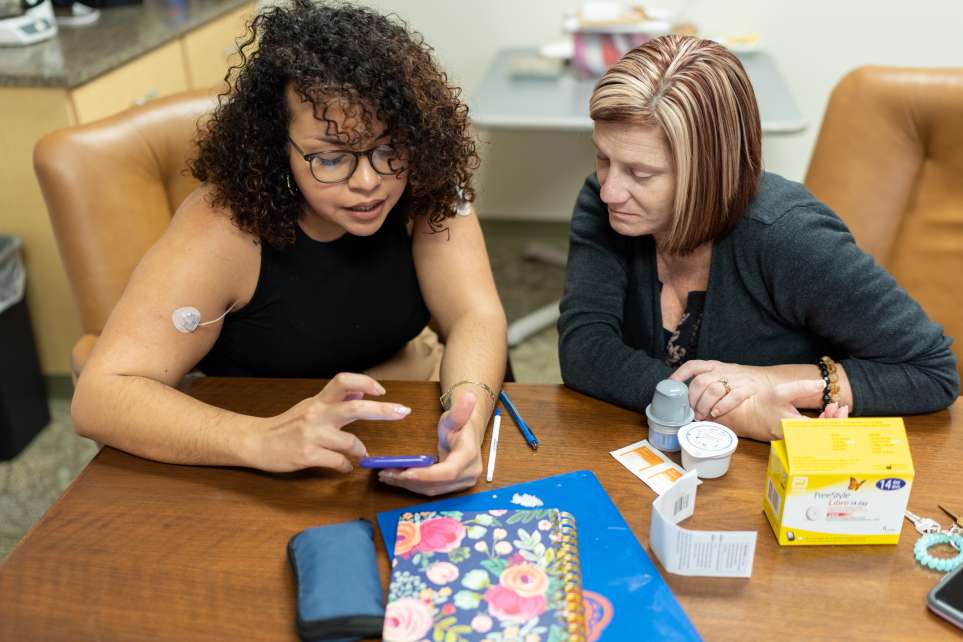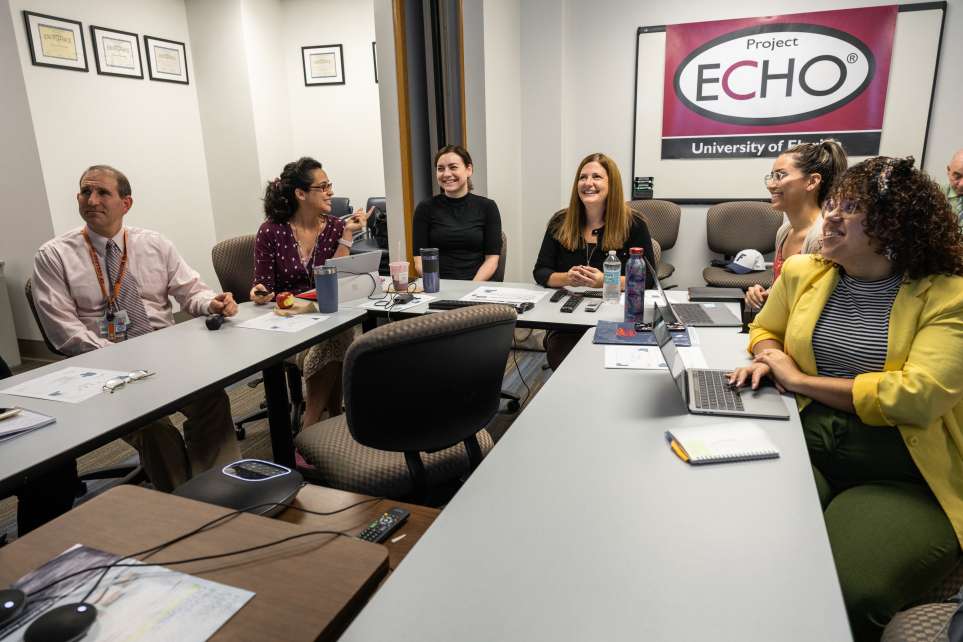When Dr. Darlene Francois diagnoses patients at Jessie Trice Community Health System in Miami with diabetes, many are devastated and confused. Some cry. Some worry about what they’ll be able to eat, what it means for their lives, for the future of their health. Some don’t know what diabetes is.
That’s when Francois introduces them to Leon Bain.
Bain sits with patients, talks about different types of diabetes, what it’s like to live with it. Bain is not a doctor, but he is an expert. He has managed his own Type 1 diabetes since he was in his early 20s. And for patients who don’t know anyone with this condition, meeting someone with personal experience can be a huge comfort.
“You’ll see a sigh of relief literally come over them,” says Bain, who has worked at the health system as a peer support coach for five years.
Type 1 diabetes is not a medical condition that can be treated in a doctor’s office alone. It requires regular doses of insulin alongside constant management of diet and other aspects of daily life — a process that can be both practically and emotionally exhausting. Peer support coaches like Bain are bridging the gap between exam rooms and patients’ everyday lives, helping people with diabetes understand the disease, access treatment resources, and learn strategies that keep them in good health.
“The best, most amazing endocrinologist, they’re going to only see [patients] for a very short time, a few times in an entire year,” says Ashby Walker, director of health equity at the University of Florida Diabetes Institute. “This is every single day, 24 hours a day. A coach goes beyond the clinical encounter in ways that providers never could.”
More than 38 million Americans have some form of diabetes, a family of conditions that affect how the body converts food to energy. A small subset, about two million people, have forms of the disease that require treatment with insulin, a hormone that regulates blood sugar. For the most part, this applies to Type 1 diabetes, an autoimmune disease that is often diagnosed in children, though it also is true with some forms of Type 2. Without insulin and careful ongoing management of diet and lifestyle, the condition can be fatal.
“It’s just incredibly burdensome, mentally, physically, economically,” says Dr. Michael Haller, chief of pediatric endocrinology at the University of Florida and a collaborator on the research project.
Crushed by negative news?
Sign up for the Reasons to be Cheerful newsletter.
There are significant disparities in how the disease affects people of different backgrounds. Globally, historically marginalized communities are disproportionately impacted by diabetes and face worse health outcomes. For people with diabetes that requires insulin, there are devices that can help manage the condition, like wearable pumps that supply insulin and monitors that track blood sugar levels. But those technologies can be expensive, and use of them is lower among populations that are at highest risk of poor outcomes. In the US, for instance, Black children with Type 1 diabetes have higher rates of complications and are more likely to be hospitalized, while they also use technology at lower rates than other groups.
As difficult as it is to manage insulin-requiring diabetes, it is possible. Haller and Walker worked together on a research initiative, Project ECHO, which aimed to train up primary care providers at health clinics in underserved areas to better treat diabetes. They added an extra component: embedding a non-medical professional with personal diabetes experience in more than 35 federally qualified health centers in Florida and California. Bain, in Miami, was one of them.

Physicians can offer patients advice, says Haller, like recommending they track carbohydrates in their diet to calculate insulin doses. Still, there’s a gap between hearing what a doctor says in an office and applying it in daily life.
“We tell patients these things all the time, but it just doesn’t get communicated,” he says. “It’s why I think peer coaching as a model can be so powerful.”
When Bain meets a new patient, he stays in touch — by text, by phone, in one-on-one meetings and community-building events.
“One of the things I’ve seen is acceptance,” Bain says. When he shows patients that he is living well with diabetes, they become more receptive to lifestyle and treatment options.
Bain works closely with Francois, a family nurse practitioner who specializes in diabetes. She spends her days treating patients. When she connects them with Bain, she sees how his personal experience with the disease builds credibility.
“He opens doors that I could not open,” she says.
Peer coaches don’t give medical advice, Bain explains, but they can speak about their own experiences. When a patient asks about what to do when their blood sugar is too low, Bain shares how he deals with it, like the rule of 15 — eat 15 grams of carbohydrates and check blood sugar 15 minutes later. He also serves as a conduit for all kinds of other resources, connecting patients with teams that help navigate medical issues and broader social factors, like access to healthy foods.

One of the biggest impacts of the peer support program is that many more patients are now using technology, like wearable insulin pumps and continuous glucose monitors.
Those technologies make life much easier — “it’s like having an electronic pancreas,” says Bain — but they can be expensive, hard to get and intimidating. Many patients have never heard of insulin pumps, Bain says. Using the equipment can be challenging for people who are not tech-literate, and there’s a steep learning curve to understand how to properly use the equipment to adjust blood sugar levels. And the idea of injecting insulin is off-putting. Bain remembers when he was first told that he would have to start giving himself injections. “I was petrified,” he says.
Some patients shut down, say they won’t do it. “That’s when I’ll step in and say, ‘It’s not really as bad as you think,” Bain says. “‘Let’s talk about my journey.’”
Before the peer coach program, very few Jessie Trice Community Health System patients used insulin pumps, according to Chief Medical Officer Dr. Joycelyn Lawrence. Bain and Francois’s efforts have helped more people to both accept the technology and access it. They find ways to make sure patients can get equipment, by navigating health insurance options and offering patients technology that has been donated.
“We’ve seen an improvement, a consistent improvement, in the numbers of patients that have controlled diabetes, and we know that that’s because of this program,” Lawrence says.
Across health systems that participated in Project ECHO, there was a similar increase in the use of continuous glucose monitors and insulin pumps, according to Walker and Haller. There were also clear emotional benefits: Researchers found that during the Covid-19 pandemic, patients who worked with a coach had lower levels of diabetes-related distress than other patients.
There are challenges: Peer support isn’t common in the US health system, so setting up peer support programs alongside medical providers can be logistically challenging. Burnout is also a risk, notes Walker, as peer supporters are dealing with the stresses of the disease themselves.
There are many different models of peer support, according to Ed Fisher, a professor at UNC Chapel Hill who heads the Peers for Progress program. Some are more formal and connected directly to health centers, like through Project ECHO. Others can be more community-based, or even come through apps and tech platforms.
While various peer support programs focused on diabetes have been linked to lower blood sugar levels, improved mental health and more, the approach is also useful for many other chronic conditions — from heart disease to mental health.
“Peer support is intrinsically destigmatizing, because in peer support, I help you today, you help me tomorrow,” says Fisher.
Bain has seen how powerful the connections forged around a chronic condition can be.
Over the summer, he hosted 13 people at a diabetes education event at a clinic in Miami Gardens. At one point, one attendee started to talk about how they manage diabetes. Then another one chimed in. Soon, all of them were sharing stories, relating to each other, laughing together. At events like this, Bain strives to connect people with various resources that can help them navigate life with diabetes. And the companionship and community that forms among participants, he says, is a valuable resource in itself.
“Imagine being on an island and you’re by yourself,” Bain says, “and then all of a sudden, 13 people show up that are now in the same position.”
The post Living Well With Diabetes — With Help From a Peer appeared first on Reasons to be Cheerful.




